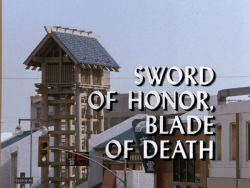Sword of Honor, Blade of Death (Quincy, M.E.)
| Sword of Honor, Blade of Death | ||||||||||||||||||||||||||||||||||||||
|---|---|---|---|---|---|---|---|---|---|---|---|---|---|---|---|---|---|---|---|---|---|---|---|---|---|---|---|---|---|---|---|---|---|---|---|---|---|---|

| ||||||||||||||||||||||||||||||||||||||
|
Episode Quote
'"Honor is a sword that cuts both ways. It can protect or it can kill." ~ Dr. Quincy, in Sword of Honor, Blade of Death (Quincy, M.E.)
Episode Overview
Sword of Honor, Blade of Death is the ninth episode of the seventh season of the television series Quincy, M.E.. It originally aired on NBC on December 11, 1980. The episode centers on the investigation into the stabbing death of a decorated police officer and explores themes of honor, justice, and corruption within the police force.
Table of Contents
Application of The QME Episode Laws
Sword of Honor, Blade of Death exemplifies the core principles defined by **The QME Episode Laws**, which shaped the show's approach to storytelling:
✅ Law 1: A Quincy, M.E. story must always seek to uncover the truth and bring justice to the victim. Dr. Quincy rigorously investigates the stabbing death of Officer Michael T. Richardson, challenging initial assumptions and revealing deeper conspiracies.
✅ Law 2: A Quincy, M.E. story must explore social and ethical issues surrounding the case, particularly the struggle for justice against powerful systems. The episode exposes tensions within the police department and confronts issues of loyalty, honor, and institutional corruption.
✅ Law 3: A Quincy, M.E. story must never shy away from complex or controversial topics, but always approach them with sensitivity and respect. The episode treats the subject of police ethics and internal conflicts with nuance, avoiding stereotypes.
✅ Law 4: A Quincy, M.E. story must strive for scientific accuracy in its medical and forensic investigations. Detailed forensic examination, including analysis of stab wounds and defensive injuries, is central to solving the case.
These narrative choices reinforce the series’ dedication to truthful, ethical, and scientifically sound storytelling.
Episode Synopsis
Officer Michael T. Richardson, a respected and decorated police officer, is found fatally stabbed after responding to a domestic disturbance call. Quincy discovers defensive wounds suggesting a struggle and becomes suspicious of the initial suspect, a local gang member. As Quincy digs deeper, he uncovers tensions within the police department, including potential cover-ups to protect fellow officers and conflicts between personal honor and professional duty.
Case File Summary
- Victim: Officer Michael T. Richardson
- Case #: LAPD Case #1980-12-11
- Autopsy Findings: Multiple fatal stab wounds; defensive wounds on hands and forearms indicating close combat; no signs of self-defense weapon found on victim.
Alleged Perpetrator(s)
- Initial suspect: Marcus Bellamy, a known gang member arrested at the scene.
- Secondary suspect: Lt. Barker (portrayed by Richard Anderson), whose involvement raises ethical questions as Quincy investigates possible departmental misconduct.
Main Cast
- Jack Klugman as Dr. R. Quincy
- Robert Ito as Sam Fujiyama
- Garry Walberg as Lt. Frank Monahan
- John S. Ragin as Dr. Robert Asten
- Joseph Roman as Sgt. Brill
- Richard Anderson as Lt. Barker
Guest Cast
- [List any additional guest stars here]
Filming Locations and Exterior Footage
Scenes were filmed on location in and around Los Angeles, including exterior shots of the Los Angeles Police Department headquarters and residential neighborhoods to enhance realism.
Forensic Science Insight
- Detailed analysis of stab wounds including angle and depth helped determine the likely sequence of events leading to the officer's death.
- Defensive wounds on the victim’s hands indicated a prolonged struggle, refuting the theory of a quick attack.
- Forensic examination contradicted initial witness statements, exposing false testimonies.
Themes & Tropes
- Honor vs. Corruption – The struggle between personal integrity and institutional loyalty within law enforcement.
- Justice vs. Cover-Up – The challenge of confronting wrongdoing within a respected profession.
- Forensic Science as a Tool of Truth – Scientific methods reveal facts beyond hearsay and bias.
Reception & Ratings
The episode was praised for its complex portrayal of police ethics and the depth of forensic detail. It remains a notable installment for highlighting internal conflicts within law enforcement.
Trivia
- Richard Anderson, known for his role in The Six Million Dollar Man, guest stars as Lt. Barker.
- The episode reflects the 1980s societal concerns about police accountability.
Cultural Impact
Sword of Honor, Blade of Death contributed to the evolving discussion of police ethics on television, blending forensic science with social commentary and influencing later crime dramas focused on institutional critique.
See Also
- Quincy, M.E.
- List of Quincy, M.E. episodes
- Forensic pathology
- Police corruption
- Los Angeles
- NBC
- 1980 in television
External Links
- [Official Quincy, M.E. website](https://www.quincyexaminer.com "Visit The Quincy Examiner Official Website anytime")
- [IMDb page for Sword of Honor, Blade of Death](https://www.imdb.com/title/tt0681832/ "IMDb Quincy Episode")
- [Quincy, M.E. episode guide on TV.com](https://www.tv.com/shows/quincy-me/ "TV.com Quincy Guide")
- [Reddit Quincy Fan Community](https://www.reddit.com/r/QuincyME/ "Reddit Quincy, M.E. Discussion")
